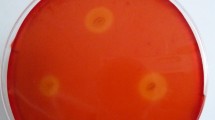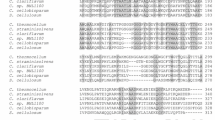Abstract
Cel6D from Paenibacillus barcinonensis is a modular cellobiohydrolase with a novel molecular architecture among glycosyl hydrolases of family 6. It contains an N-terminal catalytic domain (family 6 of glycosyl hydrolases (GH6)), followed by a fibronectin III-like domain repeat (Fn31,2) and a C-terminal family 3b cellulose-binding domain (CBM3b). The enzyme has been identified and purified showing catalytic activity on cellulosic substrates and cellodextrins, with a marked preference for phosphoric acid swollen cellulose (PASC). Analysis of mode of action of Cel6D shows that it releases cellobiose as the only hydrolysis product from cellulose. Kinetic parameters were determined on PASC showing a K m of 68.73 mg/ml and a V max of 1.73 U/mg. A series of truncated derivatives of Cel6D have been constructed and characterized. Deletion of CBM3b caused a notable reduction in hydrolytic activity, while deletion of the Fn3 domain abolished activity, as the isolated GH6 domain was not active on any of the substrates tested. Mutant enzymes Cel6D-D146A and Cel6D-D97A were constructed in the residues corresponding to the putative acid catalyst and to the network for the nucleophilic attack. The lack of activity of the mutant enzymes indicates the important role of these residues in catalysis. Analysis of cooperative activity of Cel6D with cellulases from the same producing P. barcinonensis strain reveals high synergistic activity with processive endoglucanase Cel9B on hydrolysis of crystalline substrates. The characterized cellobiohydrolase can be a good contribution for depolymerization of cellulosic substrates and for the deconstruction of native cellulose.





Similar content being viewed by others
References
Baramee S, Teeravivattanakit T, Phitsuwan P, Waeonukul R, Pason P, Tachaapaikoon C, Kosugi A, Sakka K, Ratanakhanokchai K (2016) A novel GH6 cellobiohydrolase from Paenibacillus curdlanolyticus B-6 and its synergistic action on cellulose degradation. Appl Microbiol Biotechnol 1–14. doi: 10.1007/s00253-016-7895-8
Bayer EA, Shoham Y, Lamed R (2006) Cellulose-decomposing bacteria and their enzyme systems. In: Dworkin M, Falkow S, Rosenberg E, Schleifer K-H, Stackebrandt E (eds) The prokaryotes. Vol. 2: ecophysiology and biochemistry. Springer, New York, pp 578–617
Blanco A, Díaz P, Martínez J, Vidal T, Torres AL, Pastor FI (1998) Cloning of a new endoglucanase gene from Bacillus sp. BP-23 and characterisation of the enzyme. Performance in paper manufacture from cereal straw. Appl Microbiol Biotechnol 50:48–54
Boraston AB, Bolam DN, Gilbert HJ, Davies GJ (2004) Carbohydrate-binding modules: fine-tuning polysaccharide recognition. Biochem J 382:769–781. doi:10.1042/BJ20040892
Bradford MM (1976) A rapid and sensitive method for the quantitation of microgram quantities of protein utilizing the principle of protein-dye binding. Anal Biochem 72:248–254
Britton HTS (1952) Hydrogen ions, 2nd edn. Chapman and Hall, London
Cadena EM, Chriac AI, Pastor FIJ, Diaz P, Vidal T, Torres AL (2010) Use of cellulases and recombinant cellulose binding domains for refining TCF kraft pulp. Biotechnol Prog 26:960–967. doi:10.1002/btpr.411
Carrard G, Koivula A, Söderlund H, Béguin P (2000) Cellulose-binding domains promote hydrolysis of different sites on crystalline cellulose. Proc Natl Acad Sci U S A 97:10342–10347. doi:10.1073/pnas.160216697
Chandel AK, Chandrasekhar G, Silva MB, Silvério da Silva S (2012) The realm of cellulases in biorefinery development. Crit Rev Biotechnol 32:187–202. doi:10.3109/07388551.2011.595385
Chiriac AI, Cadena EM, Vidal T, Torres AL, Diaz P, Javier Pastor FI, Pastor FIJ (2010) Engineering a family 9 processive endoglucanase from Paenibacillus barcinonensis displaying a novel architecture. Appl Microbiol Biotechnol 86:1125–1134. doi:10.1007/s00253-009-2350-8
Delidovich I, Leonhard K, Palkovits R (2014) Cellulose and hemicellulose valorisation: an integrated challenge of catalysis and reaction engineering. Energy Environ Sci 7:2803–2830. doi:10.1039/C4EE01067A
Fägerstam LG, Pettersson LG (1980) The 1,4-β-glucan cellobiohydrolases of Trichoderma reesei QM 9414. FEBS Lett 119:97–100. doi:10.1016/0014-5793(80)81006-4
Ficko-Blean E, Gregg KJ, Adams JJ, Hehemann J-H, Czjzek M, Smith SP, Boraston AB (2009) Portrait of an enzyme, a complete structural analysis of a multimodular β-N-acetylglucosaminidase from Clostridium perfringens. J Biol Chem 284:9876–9884. doi:10.1074/jbc.M808954200
Forsberg Z, Mackenzie AK, Sorlie M, Rohr AK, Helland R, Arvai AS, Vaaje-Kolstad G, Eijsink VGH (2014) Structural and functional characterization of a conserved pair of bacterial cellulose-oxidizing lytic polysaccharide monooxygenases. Proc Natl Acad Sci 111:8446–8451. doi:10.1073/pnas.1402771111
Gilad R, Rabinovich L, Yaron S, Bayer EA, Lamed R, Gilbert HJ, Shoham Y (2003) Cell, a noncellulosomal family 9 enzyme from Clostridium thermocellum, is a processive endoglucanase that degrades crystalline cellulose. J Bacteriol 185:391–398. doi:10.1128/JB.185.2.391-398.2003
Gilbert HJ, Knox JP, Boraston AB (2013) Advances in understanding the molecular basis of plant cell wall polysaccharide recognition by carbohydrate-binding modules. Curr Opin Struct Biol 23:669–677. doi:10.1016/j.sbi.2013.05.005
Hervé C, Rogowski A, Blake AW, Marcus SE, Gilbert HJ, Knox JP (2010) Carbohydrate-binding modules promote the enzymatic deconstruction of intact plant cell walls by targeting and proximity effects. Proc Natl Acad Sci U S A 107:15293–15298. doi:10.1073/pnas.1005732107
Horn S, Vaaje-Kolstad G, Westereng B, Eijsink VG (2012) Novel enzymes for the degradation of cellulose. Biotechnol Biofuels 5:45. doi:10.1186/1754-6834-5-45
Hubbe MA, Rojas OJ, Lucia LA (2015) Green modification of surface characteristics of cellulosic materials at the molecular or nano scale: a review. Bioresources 10:6095–6206
Jindou S, Xu Q, Kenig R, Shulman M, Shoham Y, Bayer EA, Lamed R (2006) Novel architecture of family-9 glycoside hydrolases identified in cellulosomal enzymes of Acetivibrio cellulolyticus and Clostridium thermocellum. FEMS Microbiol Lett 254:308–316. doi:10.1111/j.1574-6968.2005.00040.x
Kataeva IA, Seidel RD, Shah A, West LT, Li X-L, Ljungdahl LG (2002) The fibronectin type 3-like repeat from the Clostridium thermocellum cellobiohydrolase CbhA promotes hydrolysis of cellulose by modifying its surface. Appl Environ Microbiol 68:4292–4300. doi:10.1128/AEM.68.9.4292-4300.2002
Koivula A, Kinnari T, Harjunpää V, Ruohonen L, Teleman A, Drakenberg T, Rouvinen J, Jones TA, Teeri TT (1998) Tryptophan 272: an essential determinant of crystalline cellulose degradation by Trichoderma reesei cellobiohydrolase Cel6A. FEBS Lett 429:341–346
Koivula A, Ruohonen L, Wohlfahrt G, Reinikainen T, Teeri TT, Piens K, Claeyssens M, Weber M, Vasella A, Becker D, Sinnott ML, Zou JY, Kleywegt GJ, Szardenings M, Ståhlberg J, Jones TA (2002) The active site of cellobiohydrolase Cel6A from Trichoderma reesei: the roles of aspartic acids D221 and D175. J Am Chem Soc 124:10015–10024. doi:10.1021/ja012659q
Laemmli UK (1970) Cleavage of structural proteins during the assembly of the head of bacteriophage T4. Nature 227:680–685
Lombard V, Golaconda Ramulu H, Drula E, Coutinho PM, Henrissat B (2014) The carbohydrate-active enzymes database (CAZy) in 2013. Nucleic Acids Res 42:D490–D495. doi:10.1093/nar/gkt1178
Lynd LR, Weimer PJ, van Zyl WH, Pretorius IS (2002) Microbial cellulose utilization: fundamentals and biotechnology. Microbiol Mol Biol Rev 66:506–577. doi:10.1128/MMBR.66.3.506-577.2002
Meinke A, Gilkes NR, Kwan E, Kilburn DG, Warren RA, Miller RC (1994) Cellobiohydrolase A (CbhA) from the cellulolytic bacterium Cellulomonas fimi is a β-1,4-exocellobiohydrolase analogous to Trichoderma reesei CBH II. Mol Microbiol 12:413–422
Mingardon F, Bagert JD, Maisonnier C, Trudeau DL, Arnold FH (2011) Comparison of family 9 cellulases from mesophilic and thermophilic bacteria. Appl Environ Microbiol 77:1436–1442. doi:10.1128/AEM.01802-10
Padilha IQM, Valenzuela SV, Grisi TCSL, Diaz P, de Araújo DAM, Pastor FIJ (2014) A glucuronoxylan-specific xylanase from a new Paenibacillus favisporus strain isolated from tropical soil of Brazil. Int Microbiol 17:175–184. doi:10.2436/IM.V17I3.136532
Park C, Kawaguchi T, Sumitani J-I, Takada G, Izumori K, Arai M (2005) Cloning and sequencing of an exoglucanase gene from Streptomyces sp. M 23, and its expression in Streptomyces lividans TK-24. J Biosci Bioeng 99:434–436. doi:10.1263/jbb.99.434
Poidevin L, Feliu J, Doan A, Berrin J-G, Bey M, Coutinho PM, Henrissat B, Record E, Heiss-Blanquet S (2013) Insights into exo- and endoglucanase activities of family 6 glycoside hydrolases from Podospora anserina. Appl Environ Microbiol 79:4220–4229. doi:10.1128/AEM.00327-13
Sánchez MM, Pastor FIJ, Diaz P (2003) Exo-mode of action of cellobiohydrolase Cel48C from Paenibacillus sp. BP-23. A unique type of cellulase among Bacillales. Eur J Biochem 270:2913–2919. doi:10.1046/j.1432-1033.2003.03673.x
Sánchez MM, Irwin DC, Pastor FIJ, Wilson DB, Diaz P (2004) Synergistic activity of Paenibacillus sp. BP-23 cellobiohydrolase Cel48C in association with the contiguous endoglucanase Cel9B and with endo- or exo-acting glucanases from Thermobifida fusca. Biotechnol Bioeng 87:161–169. doi:10.1002/bit.20099
Sánchez MM, Fritze D, Blanco A, Spröer C, Tindall BJ, Schumann P, Kroppenstedt RM, Diaz P, Pastor FIJ (2005) Paenibacillus barcinonensis sp. nov., a xylanase-producing bacterium isolated from a rice field in the Ebro River delta. Int J Syst Evol Microbiol 55:935–939. doi:10.1099/ijs.0.63383-0
Sandgren M, Wu M, Karkehabadi S, Mitchinson C, Kelemen BR, Larenas EA, Ståhlberg J, Hansson H (2013) The structure of a bacterial cellobiohydrolase: the catalytic core of the Thermobifida fusca family GH6 cellobiohydrolase Cel6B. J Mol Biol 425:622–635. doi:10.1016/j.jmb.2012.11.039
Spiro RG (1966) Analysis of sugars found in glycoproteins. Methods Enzymol 8:3–26
Teeri TT (1997) Crystalline cellulose degradation: new insight into the function of cellobiohydrolases. Trends Biotechnol 15:160–167. doi:10.1016/S0167-7799(97)01032-9
Tomme P, Van Tilbeurgh H, Pettersson G, Van Damme J, Vandekerckhove J, Knowles J, Teeri T, Claeyssens M (1988) Studies of the cellulolytic system of Trichoderma reesei QM 9414. Analysis of domain function in two cellobiohydrolases by limited proteolysis. Eur J Biochem 170:575–581
Tomme P, Boraston A, McLean B, Kormos J, Creagh AL, Sturch K, Gilkes NR, Haynes CA, Warren RA, Kilburn DG (1998) Characterization and affinity applications of cellulose-binding domains. J Chromatogr B Biomed Sci Appl 715:283–296
Tormo J, Lamed R, Chirino AJ, Morag E, Bayer EA, Shoham Y, Steitz TA (1996) Crystal structure of a bacterial family-III cellulose-binding domain: a general mechanism for attachment to cellulose. EMBO J 15:5739–5751
Tuck CO, Pérez E, Horváth IT, Sheldon RA, Poliakoff M (2012) Valorization of biomass: deriving more value from waste. Science 337:695–699. doi:10.1126/science.1218930
Valenzuela SV, Lopez S, Biely P, Sanz-Aparicio J, Pastor FIJ (2016) The glycoside hydrolase family 8 reducing-end xylose-releasing exo-oligoxylanase Rex8A from Paenibacillus barcinonensis BP-23 is active on branched xylooligosaccharides. Appl Environ Microbiol 82:5116–5124. doi:10.1128/AEM.01329-16
Vuong TV, Wilson DB (2009b) Processivity, synergism, and substrate specificity of Thermobifida fusca Cel6B. Appl Environ Microbiol 75:6655–6661. doi:10.1128/AEM.01260-09
Vuong TV, Wilson DB (2009a) The absence of an identifiable single catalytic base residue in Thermobifida fusca exocellulase Cel6B. FEBS J 276:3837–3845. doi:10.1111/j.1742-4658.2009.07097.x
Watson DL, Wilson DB, Walker LP (2002) Synergism in binary mixtures of Thermobifida fusca cellulases Cel6B, Cel9A, and Cel5A on BMCC and Avicel. Appl Biochem Biotechnol 101:97–111. doi:10.1385/ABAB:101:2:097
Wohlfahrt G, Pellikka T, Boer H, Teeri TT, Koivula A (2003) Probing pH-dependent functional elements in proteins: modification of carboxylic acid pairs in Trichoderma reesei cellobiohydrolase Cel6A. Biochemistry 42:10095–10103. doi:10.1021/BI034954O
Wood TM (1988) Preparation of crystalline, amorphous, and dyed cellulase substrates. In: Meth Enzymol. pp 19–25
Yaniv O, Petkun S, Shimon LJW, Bayer EA, Lamed R, Frolow F (2012) A single mutation reforms the binding activity of an adhesion-deficient family 3 carbohydrate-binding module. Acta Crystallogr D Biol Crystallogr 68:819–828. doi:10.1107/S0907444912013133
Zhang S, Lao G, Wilson DB (1995) Characterization of a Thermomonospora fusca exocellulase. Biochemistry 34:3386–3395
Zhang Y-HP, Cui J, Lynd LR, Kuang LR (2006) A transition from cellulose swelling to cellulose dissolution by o-phosphoric acid: evidence from enzymatic hydrolysis and supramolecular structure. Biomacromolecules 7:644–648. doi:10.1021/bm050799c
Acknowledgements
This work was partially supported by the Spanish Ministry of Economy and Competitivity, grant no. CTQ2013-48995-C2-2-R. Liliana Cerda-Mejía held a grant SENESCYT (Ecuador). The experiments described in this article have been performed complying with the Spanish current laws.
Author information
Authors and Affiliations
Corresponding author
Ethics declarations
Conflict of interest
The authors declare that they have no competing interests.
Ethical approval
This article does not contain any studies with human participants or animals performed by any of the authors.
Rights and permissions
About this article
Cite this article
Cerda-Mejía, L., Valenzuela, S.V., Frías, C. et al. A bacterial GH6 cellobiohydrolase with a novel modular structure. Appl Microbiol Biotechnol 101, 2943–2952 (2017). https://doi.org/10.1007/s00253-017-8129-4
Received:
Revised:
Accepted:
Published:
Issue Date:
DOI: https://doi.org/10.1007/s00253-017-8129-4




